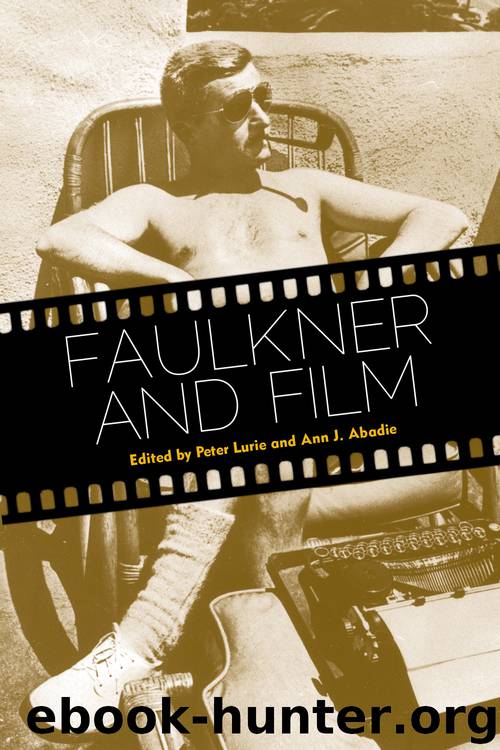Faulkner and Film by Peter Lurie & Ann J. Abadie

Author:Peter Lurie & Ann J. Abadie
Language: eng
Format: epub
Publisher: University Press of Mississippi
Published: 2014-03-14T16:00:00+00:00
NOTES
1. Pier Paolo Pasolini, “The Screenplay as a ‘Structure That Wants to Be Another Structure,’” in Heretical Empiricism, ed. Louise K. Barnett and Ben Lawson (Bloomington: Indiana University Press, 1988), 187.
2. Joseph Blotner, Faulkner: A Biography (London: Chatto & Windus, 1974), 2:1197.
3. See Albert J. LaValley, “Introduction: A Troublesome Property to Script,” in Ranald MacDougall, Mildred Pierce, ed. Albert J. LaValley (Madison: University of Wisconsin Press, 1980), 34–35.
4. Faulkner to Robert K. Haas, January 15, 1944, in Selected Letters of William Faulkner, ed. Joseph Blotner (New York: Random House, 1977), 180.
5. Faulkner to Harold Ober, April 24, 1947, in Selected Letters, 248.
6. Faulkner to Harold Ober, November 17, 1943, in Selected Letters, 178.
7. “Not even A Fable manifests any special signs of being intentionally based on film techniques, in spite of the fact that this novel was initially conceived as a film scenario and was not finished until after Faulkner had completed his three principal sojourns.” Gene D. Phillips, Fiction, Film, and Faulkner: The Art of Adaptation (Knoxville: University of Tennessee Press, 1988), 56.
8. Joseph Blotner and Noel Polk, “Note on the Texts,” in William Faulkner: Novels 1942–1954: Go Down, Moses, Intruder in the Dust, Requiem for a Nun, A Fable, ed. Joseph Blotner and Noel Polk (New York: Library of America, 1994), 1109.
9. William Faulkner, William Faulkner Manuscripts 20, Volume I: “A Fable,” Miscellaneous Holograph and Typescript Pages, Part 1, arr. Michael Millgate (New York: Garland Publishing, 1986), 1.
10. Faulkner, A Fable, in William Faulkner: Novels 1942–1954, 669–70. References hereafter are to this edition and will be cited parenthetically within the text.
11. Joseph Urgo, Faulkner’s Apocrypha: “A Fable” Snopes, and the Spirit of Human Rebellion (Jackson: University Press of Mississippi, 1989), 120.
12. Richard Godden, William Faulkner: An Economy of Complex Words (Princeton: Princeton University Press, 2007), 158.
13. John T. Matthews, William Faulkner: Seeing through the South (Malden, Mass.: Blackwell, 2009), 276, 278.
14. Peter Nicolaisen, “Collective Experience and Questions of Genre in A Fable,” in The Artist and His Masks: William Faulkner’s Metafiction, ed. Agostino Lombardo (Rome: Bulzone Editore, 1991), 414, 413.
15. See Walter Benjamin, “On Some Motifs in Baudelaire,” in Illuminations, trans. Harry Zohn, ed. Hannah Arendt (New York: Schocken Books, 1968), 175.
16. See ibid.
17. Anton Kaes, “Movies and Masses,” in Crowds, ed. Jeffrey T. Schnapp and Matthew Tiews (Stanford: Stanford University Press, 2006), 156–57.
18. Faulkner, “The De Gaulle Story: First Complete Screenplay,” in Faulkner: A Comprehensive Guide to the Brodsky Collection, vol. 3: The De Gaulle Story, ed. Louis Daniel Brodsky and Robert W. Hamblin (Jackson: University Press of Mississippi, 1984), 188.
19. See Susan Buck-Morss, Dreamworld and Catastrophe: The Passing of Mass Utopia in East and West (Cambridge: MIT Press, 2002), 134ff.
20. Ibid., 140.
21. Walter Benjamin, “The Work of Art in the Age of Mechanical Reproduction,” 251, n. 21.
22. Siegfried Kracauer, Theory of Film: The Redemption of Physical Reality (London: Oxford University Press, 1973), 158.
23. See Buck-Morss, Dreamworld and Catastrophe, 134.
24. See Susan Buck-Morss, “The Cinema Screen as Prosthesis of Perception: A Historical Account,” in The Senses Still: Perception and Memory as Material Culture in Modernity, ed.
Download
This site does not store any files on its server. We only index and link to content provided by other sites. Please contact the content providers to delete copyright contents if any and email us, we'll remove relevant links or contents immediately.
Call Me by Your Name by André Aciman(20371)
Ready Player One by Cline Ernest(14523)
How to Be a Bawse: A Guide to Conquering Life by Lilly Singh(7391)
Wiseguy by Nicholas Pileggi(5671)
The Kite Runner by Khaled Hosseini(5082)
On Writing A Memoir of the Craft by Stephen King(4863)
Audition by Ryu Murakami(4849)
The Crown by Robert Lacey(4722)
Call me by your name by Andre Aciman(4619)
Gerald's Game by Stephen King(4581)
Harry Potter and the Cursed Child: The Journey by Harry Potter Theatrical Productions(4440)
Dialogue by Robert McKee(4321)
The Perils of Being Moderately Famous by Soha Ali Khan(4169)
Dynamic Alignment Through Imagery by Eric Franklin(4116)
Apollo 8 by Jeffrey Kluger(3636)
Seriously... I'm Kidding by Ellen DeGeneres(3577)
The Inner Game of Tennis by W. Timothy Gallwey(3575)
How to be Champion: My Autobiography by Sarah Millican(3555)
Darker by E L James(3477)
